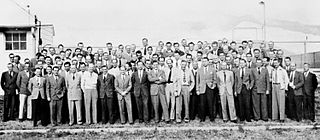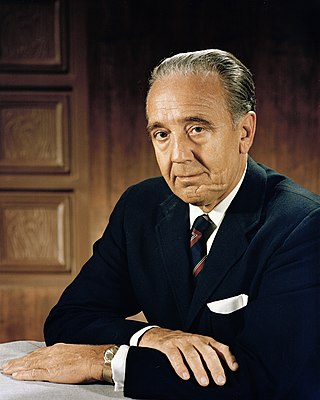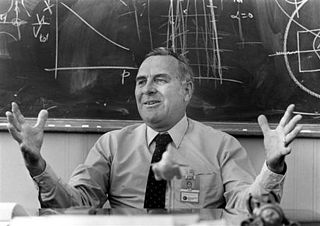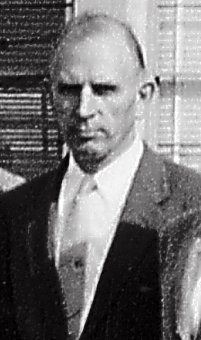
Wernher Magnus Maximilian Freiherr von Braun was a German-American aerospace engineer and space architect. He was a member of the Nazi Party and Allgemeine SS, and the leading figure in the development of rocket technology in Nazi Germany and later a pioneer of rocket and space technology in the United States.

Operation Paperclip was a secret United States intelligence program in which more than 1,600 German scientists, engineers, and technicians were taken from the former Nazi Germany to the U.S. for government employment after the end of World War II in Europe, between 1945 and 1959. Conducted by the Joint Intelligence Objectives Agency (JIOA), it was largely carried out by special agents of the U.S. Army's Counterintelligence Corps (CIC). Many of these Germans were former members and some were former leaders of the Nazi Party.

Bernhard Robert Tessmann was a German expert in guided missiles during World War II, and later worked for the United States Army and NASA.

Ernst Stuhlinger was a German-American atomic, electrical, and rocket scientist. After being brought to the United States as part of Operation Paperclip, he developed guidance systems with Wernher von Braun's team for the US Army, and later was a scientist with NASA. He was also instrumental in the development of the ion engine for long-endurance space flight, and a wide variety of scientific experiments.

Konrad Dannenberg was a German-American rocket pioneer and member of the German rocket team brought to the United States after World War II.

Kurt Heinrich Debus was a German-American rocket engineer and NASA director. Born in Germany, he was a member of the Schutzstaffel (SS) during World War II, where he served as a V-weapons flight test director. Following the war, he was brought to the United States via Operation Paperclip, and directed the design, development, construction and operation of NASA's Saturn launch facilities. He became the first director of NASA's Launch Operations Center, and, under him, NASA conducted 150 launches of military missiles and space vehicles, including 13 launches of the Saturn V rocket as part of the Apollo Moon landing program.

Georg Heinrich Patrick Baron von Tiesenhausen was a Baltic-German-born American rocket scientist.

Werner Karl Dahm was an early spaceflight scientist of the Peenemünde Future Projects Office who emigrated to the US under Operation Paperclip and was the Marshall Space Flight Center Chief Aerodynamicist.

Axel Roth was born in Darmstadt, Germany, on October 25, 1936. He was the son of Ludwig Roth, an original member, of the German Rocket Team. He survived World War II, RAF bombing of rocket development facility at Peenemünde, Germany, August 17–18, 1943, known as Operation Crossbow. He arrived in the US in New York City, NY in 1946, a year after his father arrived there as part of Operation Paperclip, aboard a converted troop transport. He moved first to Ft. Bliss, Texas, and then to Huntsville, Alabama in 1950 when the German Rocket Team was relocated to Redstone Arsenal, Alabama.

Walter Haeussermann was a German-American aerospace engineer and member of the "von Braun rocket group", both at Peenemünde and later at Marshall Space Flight Center, where he was the director of the guidance and control laboratory. He was awarded the Department of the Army Decoration for Exceptional Civilian Service in 1959 for his contributions to the US rocket program.

Walter Jacobi was a rocket scientist and member of the "von Braun rocket group", at Peenemünde (1939–1945) working on the V-2 rockets in World War II.

Hans Hermann Hüter was a German-Swiss rocket engineer.

William "Willi" Mrazek was a German-American loads engineer and member of the "von Braun rocket group." Mrazek worked first at Peenemünde Army Research Center and later, through Operation Paperclip, at Fort Bliss and the Marshall Space Flight Center, where he was involved with the development of the Saturn V rocket.

Werner Richard Kuers was a German-American engineer and expert in guided missiles. Kuers worked at Peenemünde Army Research Center in manufacturing and later, as part of the "von Braun rocket group" through Operation Paperclip, at White Sands V-2 Launching Site and the Marshall Space Flight Center.
Heinz Hilten was a German-American architect and member of the "von Braun rocket team." He was a later Operation Paperclip hire and was involved in the design of numerous buildings in Space Age-era Huntsville, Alabama, both for NASA and for general use.
Gerhard Herbert Richard Reisig was a German-American engineer and rocket scientist. He worked at the Peenemünde Army Research Center during World War II and later, through Operation Paperclip, at the Marshall Space Flight Center.
Helmut Justus Karl Horn was a German-American engineer and applied physicist who was employed at the early Marshall Space Flight Center. Horn worked first at the Peenemünde Army Research Center and later, after the end of World War II, was hired by the U.S. through Operation Paperclip.
Gerhard B. Heller was a German-American rocket scientist and member of the "von Braun rocket team." He worked at Peenemünde Army Research Center during World War II and later, through Operation Paperclip, moved to develop rockets for the U.S., eventually becoming employed at the Marshall Space Flight Center.

Heinrich Georg "Heinz" Struck was a German-American rocket scientist and member of the "von Braun rocket team." Struck worked in aerodynamics in both the private and federal sectors, particularly NASA, where he was recognized for his contributions to the Space Shuttle program.
William August Schulze was a German-American rocket scientist and Operation Paperclip hire. After involvement with the development of numerous German rockets during World War II, he became one of the first seven Operation Paperclip scientists and engineers to enter the United States, where he served in directing the PGM-11 Redstone program.















